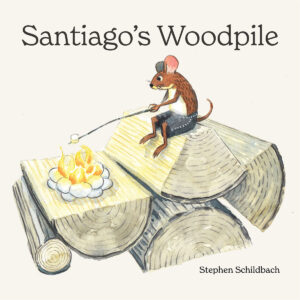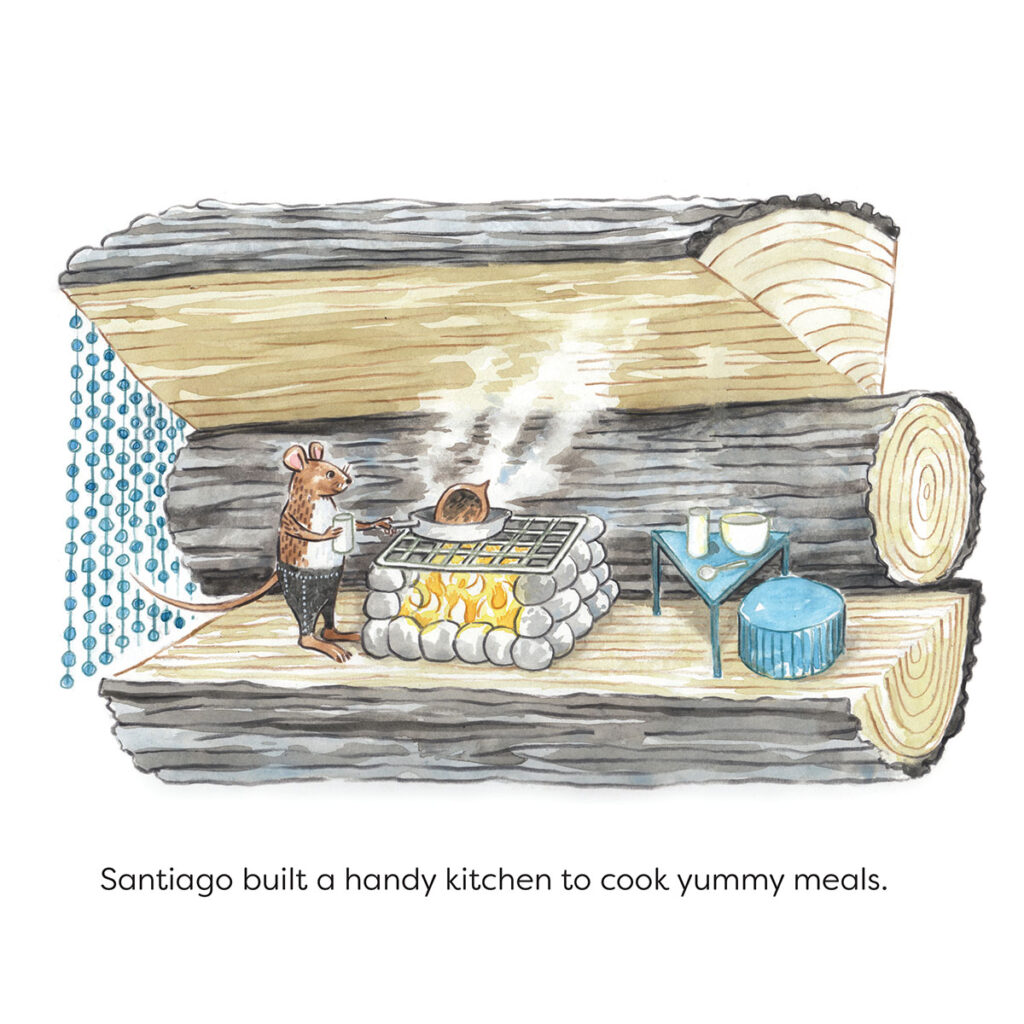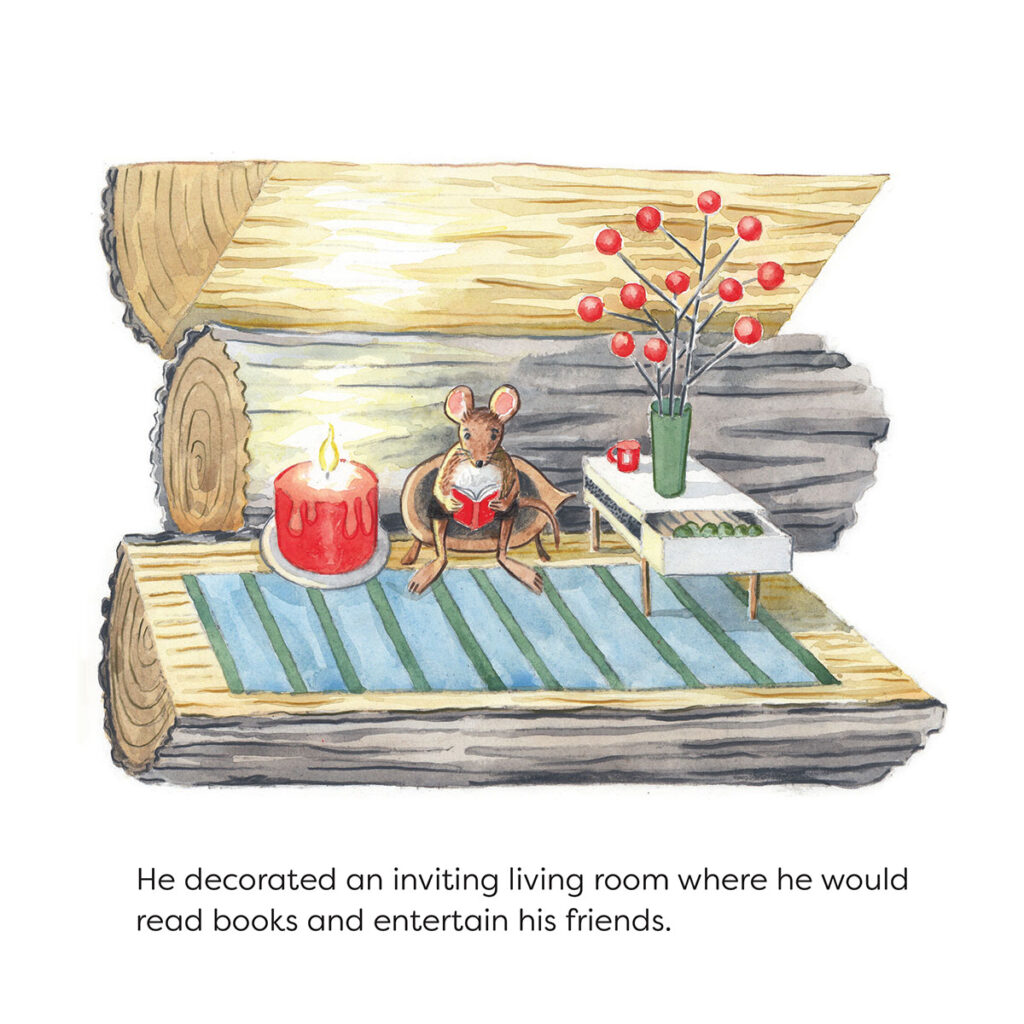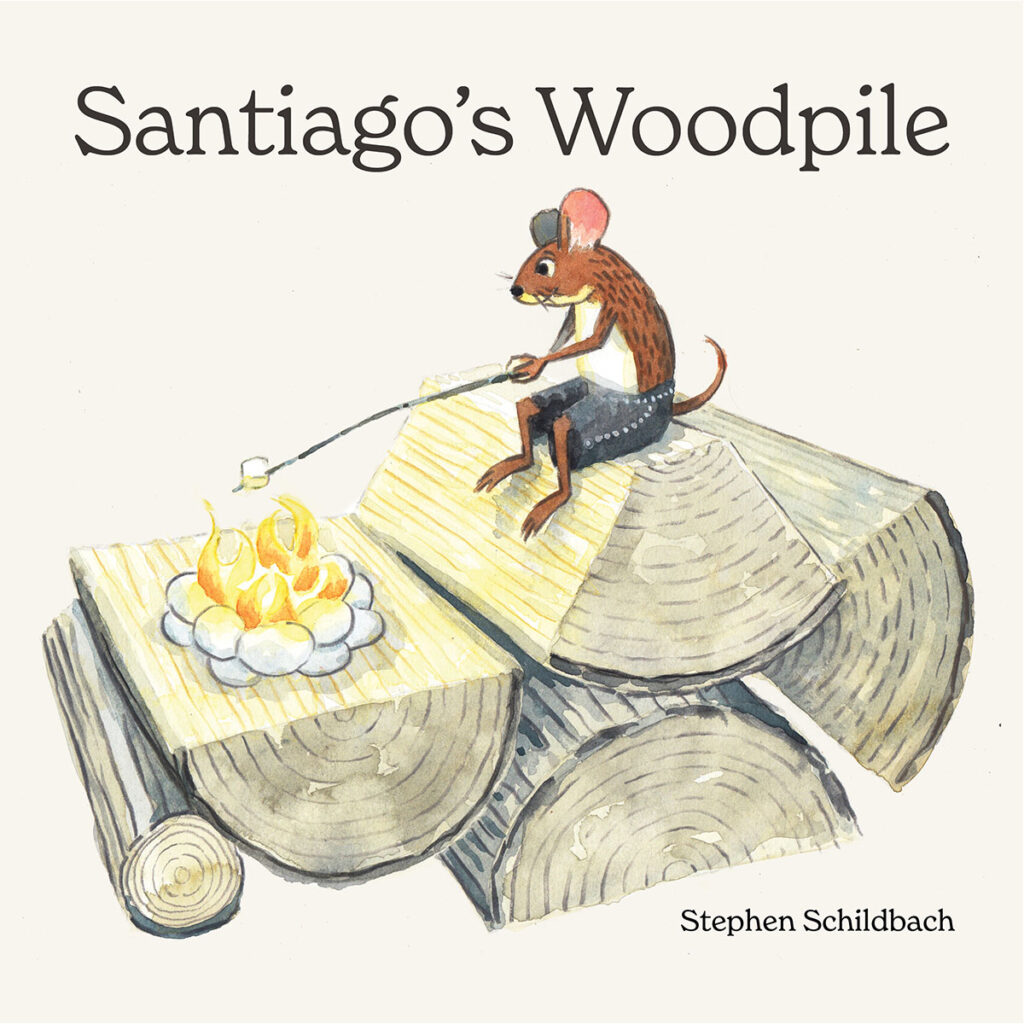By Stephen Schildbach

Impracticality is deciding to write and illustrate a children’s book while working a full-time job. I’ve never written a children’s book. And long gone is an illustration career that once provided my full income. I’m a full-time web designer, and have two children to support with my wife. The available time to do such a large project could only be found in small increments.
However, being a creative person, making things can be a sort of addiction. The personal desire to both author and illustrate my first children’s book midlife occurred from reading to my children. I was also motivated by the thought that my youngest child would enjoy the book and I would get fulfillment reading it to him.
I moved to Vashon Island in August of 2022, and moving to a new environment stirs up the imagination. The inspiration for “Santiago’s Woodpile” came from living in a log cabin that is an enticing home to mice (even though we do our best to keep them out). At the same time, my eldest child had been playing with Calico Critters (cute little miniature figures) for years, and these little worlds she created were adorable to behold. Lastly, there were the many woodpiles I saw stacked around the Island.
Sometime in February of 2023, while drifting off to sleep one night, the idea of a mouse living in a woodpile came to me. I started to think of what a story for this little mouse might be, and I named him Santiago. This would be the start of my book.
I did not want this book to be a vanity project. I knew deep down that this was about more than the children’s book. It was also a practice in strengthening my patience, discipline, and humility with any large creative project.
A children’s book appears to be simple, and it is, relative to writing an adult novel. But, like anything that is new to you, there is a lot to learn. Initially, you miss important details behind the craft. I knew how to illustrate singular images, but had not done many projects needing serial images with a consistent character. The last time I’d illustrated a children’s book (“And Then It Was Sugar,” by Margarita Gonzalez Jensen) was almost 30 years ago.
The biggest act of humility was bringing in help. Ellie Peterson, children’s book author, helped edit the story. Alan Carr, former art director at Muddle Puddle, Inc., helped edit the illustrations. I had two other friends make general edits. I can say that it was the consulting from these colleagues that raised the story up from a hobby to a book ready for the public.
I had no idea that editing was going to add so much additional time. Yet, I knew that the initial drafts were sloppy and missing key elements both visually and stylistically, especially the illustrations. It would take me two-and-a-half years to get to a point where I would be confident to present the story and illustrations.
Half way through the making of “Santiago’s Woodpile,” I had to decide whether to get an agent; approach many publishers; or self-publish. I often let little signs influence my decisions. In late 2023, I sent out my book proposal to three publishers. I heard back from one, and the email response was positive. But, the email went into my spam folder and I didn’t see it until it was far too late! I was also discouraged by the degree to which some publishers were limiting submissions to particular identity groups.
The largest discouraging factor was that publishers are not looking for new authors who illustrate their own stories. These significant details sent me to self-publishing, and my research led me to IngramSpark.
September of 2025, I’d reached completion of the book and now had to learn the details of self-publishing on IngramSpark. I’d heard many criticisms of this platform – its lack of tech support and bad-quality printing. I saw no other option without using a company that charged prices that made selling the book at a profit formidable. What committed me to using IngramSpark is that they have great distribution to online bookstores, physical bookstores, and libraries. Once I got the nuts and bolts of IngramSpark completed, I was ready for marketing.
I had a friend pronounce on Facebook that he was a failed writer. Immediately I thought, he wasn’t a failed writer, he just has the same problem most artists have – marketing their work. I have become determined not to be that same failed writer and illustrator. My antidote is marketing my projects for as long as it took me to make them.
I was reminded once again of the power of asking for help. Self-publishing book consultant, April Cox, was interviewed online and suggested a book launch team. I later researched this term, and found it was quite a popular way to jumpstart book sales. As I write this article, it is the single-most effective way that I have started book sales.
You want people you’ve never met before to buy your book. One of the most effective ways to get people who have never seen your book is getting online reviews of your book on Amazon and Barnes & Noble.
Here is the moral dilemma I have no good answer to: if you don’t like Amazon, but you want people to buy your book, you probably should put your morals aside for this one detail, because it is Amazon’s book reviews that get you in front of strangers buying books. I don’t buy products from Amazon, but I made this exception, because it makes a positive impact.
Here is how a Book Launch Team works:
- Email friends, family, and even request your followers on social media accounts to become a part of your book publishing team (I called it a book publishing community)
- Those who accept the offer are on your Book Launch Team. Keep in touch with them, and instruct them along the way
- Ask your team to buy your book on Amazon or Barnes & Noble
- When they get the book, ask them to read it or read it to a child
- Ask them to take a picture of someone reading the book and send it to yourself for promotion (one of my team members took a picture of their dog looking at the book)
- Ask them to leave a review on the same site where they bought the book
- Ask them to share your book through email, social media, or whatever works for them
Another approach for me to get the word out has been reading to children in public and educational spaces. It also is a great way to give back to the community. I’ve read at Vashon Bookstore, Chautauqua Elementary, and Huckleberry School (all on Vashon). I feel like I’m on tour. My next stop is Paper Boat Booksellers, November 8th at 11:00 a.m. in West Seattle.
Publishing a book is the longest journey I’ve made on any creative project. There is one aspect to publishing a children’s book that reminds me of raising children: Day-by-day turns into month-by-month, then year-by-year. Then, they (both my children and the book) go off into the world on their own, and I’ll be “promoting them for as long as it took me to make them.”
Visit Stephen at stephenschildbach.com



